Methodologies for Determining the Service Quality of the Intercity Rail Service Based on Users’ Perceptions and Expectations in Thailand
Abstract
1. Introduction
1.1. The Rail Transportation Situation in Thailand
1.2. Intercity Rail Service Quality Attributes
1.3. The Methodologies for Determining the Quality of Transportation Services
1.4. Research Gap and Objective of This Study
2. Materials and Methods
2.1. Procedure
2.2. Material and Data Collection
2.2.1. Questionnaire Development
2.2.2. Participants and Data Collection
2.3. Analysis Methods
2.3.1. Factor Analysis
- (1)
- Exploratory factor analysis (EFA) was used to form indicator groups by focusing on a smaller number of factors than number of indicators. The factors (i.e., latent variables) were groups of indicators (i.e., observed variables). Examples of the factors in this research are vehicles, staff, services, and stations, which were grouped by factor analysis (FA). EFA is an analysis method used to survey and define common factors in order to explain correlations among observed variables. In other words, the results from EFA can reduce the observed variables by creating new variables in the form of common factors. Researchers usually utilize this method if there is not any clear supporting theory in terms of a correlation between measurement components and the score from each measurement indicator [7].
- (2)
- Confirmatory factor analysis (CFA) was used to verify the loading of each indicator. CFA was utilized when the researchers knew that the indicators were components of factors based on theory or the literature review [26]. However, there has never been a study of the composition of service quality indicators of the trains in Thailand; therefore, CFA was utilized based on the correlation structure from the results of EFA. Most research works in the transportation field focus on CFA (e.g., Jomnonkwao et al. [7], Watthanaklang et al. [17], and Ratanavaraha et al. [26]). This study applied both EFA and CFA to reduce the number of qualitative indicators of the Thai intercity rail services. Indicator group forming was considered, and indicator loading, obtained from the analyses, was utilized to create appropriate guidance to improve intercity rail services.
2.3.2. Cluster Analysis
2.3.3. Importance-Performance Analysis (IPA)
- “possible overkill” (low importance/high satisfaction): enterprises can consider reducing development in these perspectives;
- “keep up the good work” (high importance/high satisfaction): enterprises can consider continuing with these strategies;
- “low priority” (low importance/low satisfaction): the criteria in this quadrant have a low focus, and improvement is not needed;
- “concentrate here” (high importance/low satisfaction): the enterprise should urgently improve the criteria in this quadrant [30].
3. Results
3.1. Factor Analysis
3.2. Cluster Analysis
3.3. Importance-Performance Analysis (IPA)
4. Discussion
4.1. Grouping Service Quality Indicators
4.2. Notable Service Quality Indicators
5. Conclusions and Implementation
Author Contributions
Funding
Acknowledgments
Conflicts of Interest
Appendix A
| Variables | Min | Max | Mean | Standard Deviation | Skewness | Kurtosis |
|---|---|---|---|---|---|---|
| G1 | −5 | 4 | −0.148 | 1.161 | −0.317 | 2.016 |
| G2 | −5 | 4 | −0.145 | 1.323 | −0.334 | 1.541 |
| G3 | −6 | 5 | −0.111 | 1.335 | −0.229 | 2.152 |
| G4 | −5 | 5 | −0.073 | 1.237 | 0.025 | 1.626 |
| G5 | −6 | 5 | −0.124 | 1.385 | −0.006 | 2.136 |
| G6 | −5 | 5 | −0.099 | 1.317 | −0.126 | 1.907 |
| G7 | −5 | 5 | −0.120 | 1.423 | 0.227 | 1.903 |
| G8 | −6 | 5 | −0.179 | 1.499 | −0.548 | 1.981 |
| G9 | −6 | 5 | −0.143 | 1.589 | −0.615 | 1.852 |
| G10 | −4 | 5 | 0.020 | 1.295 | 0.207 | 1.531 |
| G11 | −5 | 5 | −0.122 | 1.294 | −0.238 | 2.161 |
| G12 | −6 | 5 | 0.010 | 1.360 | 0.029 | 2.097 |
| G13 | −5 | 4 | 0.002 | 1.099 | −0.048 | 1.725 |
| G14 | −6 | 4 | −0.023 | 1.162 | −0.212 | 1.918 |
| G15 | −6 | 4 | −0.070 | 1.254 | −0.335 | 2.431 |
| G16 | −6 | 4 | −0.078 | 1.189 | −0.572 | 2.875 |
| G17 | −6 | 4 | −0.068 | 1.302 | −0.215 | 2.058 |
| G18 | −6 | 6 | −0.127 | 1.289 | −0.037 | 3.760 |
| G19 | −6 | 5 | −0.132 | 1.319 | −0.405 | 2.342 |
| G20 | −6 | 5 | −0.140 | 1.192 | −0.394 | 2.848 |
| G21 | −6 | 4 | −0.111 | 1.273 | −0.391 | 2.547 |
| G22 | −5 | 5 | −0.111 | 1.203 | 0.067 | 2.733 |
| G23 | −6 | 5 | −0.018 | 1.192 | −0.399 | 3.247 |
| G24 | −6 | 4 | −0.083 | 1.255 | −0.816 | 3.723 |
| G25 | −6 | 4 | −0.086 | 1.227 | −0.387 | 2.430 |
| G26 | −5 | 4 | −0.109 | 1.314 | −0.235 | 1.635 |
| G27 | −6 | 5 | −0.177 | 1.310 | −0.939 | 3.402 |
| G28 | −6 | 5 | −0.163 | 1.268 | −0.595 | 2.890 |
| G29 | −6 | 5 | −0.265 | 1.337 | −0.499 | 2.330 |
| G30 | −6 | 5 | −0.259 | 1.487 | −0.916 | 3.200 |
| G31 | −6 | 6 | −0.028 | 1.234 | 0.376 | 3.473 |
| G32 | −4 | 6 | 0.021 | 1.229 | 0.409 | 2.935 |
| G33 | −6 | 5 | −0.096 | 1.318 | −0.238 | 2.451 |
| G34 | −6 | 6 | −0.003 | 1.221 | −0.182 | 4.001 |
| G35 | −6 | 4 | −0.005 | 1.129 | −0.263 | 2.384 |
| G36 | −6 | 4 | −0.042 | 1.192 | −0.566 | 3.428 |
| G37 | −6 | 5 | −0.102 | 1.306 | −0.281 | 3.073 |
| G38 | −6 | 5 | −0.146 | 1.373 | −0.247 | 2.084 |
| G39 | −6 | 4 | −0.003 | 1.139 | −0.326 | 2.575 |
| G40 | −4 | 4 | −0.020 | 1.108 | 0.118 | 1.259 |
| G41 | −6 | 5 | −0.153 | 1.259 | −0.289 | 2.377 |
| G42 | −6 | 5 | −0.112 | 1.297 | −0.199 | 1.956 |
| G43 | −6 | 6 | −0.337 | 1.654 | −0.546 | 1.698 |
| G44 | −6 | 5 | −0.259 | 1.457 | −0.647 | 2.713 |
| G45 | −6 | 5 | −0.262 | 1.467 | −0.423 | 1.671 |
| Variables | Mean | Normalized Importance |
|---|---|---|
| G1 | 4.850 | 2.40% |
| G2 | 4.532 | 25.80% |
| G3 | 4.759 | 47.30% |
| G4 | 4.891 | 6.50% |
| G5 | 4.810 | 21.10% |
| G6 | 4.906 | 11.10% |
| G7 | 4.789 | 28.40% |
| G8 | 4.455 | 26.80% |
| G9 | 4.441 | 26.40% |
| G10 | 5.008 | 18.20% |
| G11 | 4.808 | 44.30% |
| G12 | 4.946 | 22.30% |
| G13 | 5.276 | 11.60% |
| G14 | 5.151 | 59.40% |
| G15 | 5.085 | 44.90% |
| G16 | 5.089 | 33.10% |
| G17 | 5.042 | 8.60% |
| G18 | 4.971 | 5.40% |
| G19 | 4.954 | 15.90% |
| G20 | 5.016 | 25.80% |
| G21 | 5.124 | 54.20% |
| G22 | 5.052 | 33.20% |
| G23 | 4.912 | 28.10% |
| G24 | 4.870 | 35.00% |
| G25 | 4.924 | 83.90% |
| G26 | 4.782 | 54.30% |
| G27 | 4.623 | 16.70% |
| G28 | 4.961 | 29.50% |
| G29 | 4.774 | 68.10% |
| G30 | 4.366 | 61.50% |
| G31 | 5.096 | 19.60% |
| G32 | 5.228 | 5.00% |
| G33 | 4.841 | 27.40% |
| G34 | 5.046 | 0.90% |
| G35 | 5.018 | 45.70% |
| G36 | 5.037 | 24.50% |
| G37 | 4.904 | 16.70% |
| G38 | 4.820 | 16.30% |
| G39 | 5.143 | 37.50% |
| G40 | 5.221 | 1.20% |
| G41 | 4.984 | 31.40% |
| G42 | 4.963 | 31.50% |
| G43 | 4.187 | 11.50% |
| G44 | 4.641 | 7.90% |
| G45 | 4.725 | 100.00% |
References
- Thai Office of Transportation and Traffic Policy and Planning. Report Transportation Infastruture B.E 2561. 2019. Available online: http://www.otp.go.th/uploads/tiny_uploads/PDF/2562-06/25620614-ReportTransportInfrastructure-2561.pdf (accessed on 8 March 2020).
- Asian Development Bank. THAILAND: Supporting Railway Sector Reform. 2013. Available online: https://www.adb.org/sites/default/files/project-document/75722/46246-001-tha-tacr-01.pdf (accessed on 8 March 2020).
- Cioca, L.-I.; Ivascu, L. Risk Indicators and Road Accident Analysis for the Period 2012–2016. Sustainability 2017, 9, 1530. [Google Scholar] [CrossRef]
- Chen, F.; Shen, X.; Wang, Z.; Yang, Y. An Evaluation of the Low-Carbon Effects of Urban Rail Based on Mode Shifts. Sustainability 2017, 9, 401. [Google Scholar] [CrossRef]
- Lin, W.; Chen, B.; Xie, L.; Pan, H. Estimating Energy Consumption of Transport Modes in China Using DEA. Sustainability 2015, 7, 4225–4239. [Google Scholar] [CrossRef]
- de Oña, J.; de Oña, R. Quality of Service in Public Transport Based on Customer Satisfaction Surveys: A Review and Assessment of Methodological Approaches. Transp. Sci. 2015, 49, 605–622. [Google Scholar] [CrossRef]
- Jomnonkwao, S.; Ratanavaraha, V. Measurement modelling of the perceived service quality of a sightseeing bus service: An application of hierarchical confirmatory factor analysis. Trans. Policy 2016, 45, 240–252. [Google Scholar] [CrossRef]
- de Oña, J.; de Oña, R.; Eboli, L.; Mazzulla, G. Index numbers for monitoring transit service quality. Transp. Res. Part A Policy Pract. 2016, 84, 18–30. [Google Scholar] [CrossRef]
- Shen, W.; Xiao, W.; Wang, X. Passenger satisfaction evaluation model for Urban rail transit: A structural equation modeling based on partial least squares. Trans. Policy 2016, 46, 20–31. [Google Scholar] [CrossRef]
- Lierop, V.D.; El-Geneidy, A. Enjoying loyalty: The relationship between service quality, customer satisfaction, and behavioral intentions in public transit. Res. Transp. Econ. 2016, 59, 50–59. [Google Scholar] [CrossRef]
- Ratanavaraha, V.; Jomnonkwao, S.; Khampirat, B.; Watthanaklang, D.; Iamtrakul, P. The complex relationship between school policy, service quality, satisfaction, and loyalty for educational tour bus services: A multilevel modeling approach. Trans. Policy 2016, 45, 116–126. [Google Scholar] [CrossRef]
- Sivilevičius, H.; Maskeliūnaitė, L. The criteria for identifying the quality of passengers’ transportation by railway and their ranking using ahp method. Transport 2010, 25, 368–381. [Google Scholar] [CrossRef]
- Currie, G.; Muir, C. Understanding Passenger Perceptions and Behaviors During Unplanned Rail Disruptions. Trans. Res. Proce. 2017, 25, 392–4402. [Google Scholar] [CrossRef]
- Vos, M.C.; Hagen, M.V. Objective and subjective predictors of perceived cleanliness in train stations. Trans. Res. Proce. 2020, 42, 109–117. [Google Scholar] [CrossRef]
- Eboli, L.; Forciniti, C.; Mazzulla, G. Spatial variation of the perceived transit service quality at rail stations. Transp. Res. Part A Policy Pract. 2018, 114, 67–83. [Google Scholar] [CrossRef]
- Sun, S.; Duan, Z. Modeling passengers’ loyalty to public transit in a two-dimensional framework: A case study in Xiamen, China. Transp. Res. Part A Policy Pract. 2019, 124, 295–309. [Google Scholar] [CrossRef]
- Watthanaklang, D.; Ratanavaraha, V.; Chatpattananan, V.; Jomnonkwao, S. Measuring the motivation to ride bicycles for tourism through a comparison of tourist attractions. Trans. Policy 2016, 52, 153–163. [Google Scholar] [CrossRef]
- Zhang, C.; Liu, Y.; Lu, W.; Xiao, G. Evaluating passenger satisfaction index based on PLS-SEM model: Evidence from Chinese public transport service. Transp. Res. Part A Policy Pract. 2019, 120, 149–164. [Google Scholar] [CrossRef]
- de Oña, J.; de Oña, R.; Eboli, L.; Mazzulla, G. Perceived service quality in bus transit service: A structural equation approach. Trans. Policy 2013, 29, 219–226. [Google Scholar] [CrossRef]
- Cabral, A.M.R.; Ramos, F.D.S. Cluster analysis of the competitiveness of container ports in Brazil. Transp. Res. Part A Policy Pract. 2014, 69, 423–431. [Google Scholar] [CrossRef]
- Martilla, J.A.; James, J.C. Importance-Performance Analysis. J. Mark. 1977, 41, 77–79. [Google Scholar] [CrossRef]
- Champahom, T.; Goodary, R.; Beeharry, R.; Jomnonkwao, S.; Ratanavaraha, V. Evaluating user’s satisfaction of bus service in Mauritius: Decision tree approach. Low.Tech. Inter. 2019, 20, 478–489. Available online: http://cot.unhas.ac.id/journals/index.php/ialt_lti/article/view/611/484 (accessed on 1 March 2020).
- Ograjenšek, I.; Gal, I. The Concept and Assessment of Customer Satisfaction. In Modern Analysis of Customer Surveys; Wiley: Hoboken, NJ, USA, 2011; pp. 107–127. [Google Scholar]
- Soza-Parra, J.; Raveau, S.; Muñoz, J.C.; Cats, O. The underlying effect of public transport reliability on users’ satisfaction. Transp. Res. Part A Policy Pract. 2019, 126, 83–93. [Google Scholar] [CrossRef]
- Hair, J.F.; Black, W.C.; Babin, B.J.; Anderson, R.E. Multivariate Data Analysis; Pearson Education Limited: Harlow, UK, 2013. [Google Scholar]
- Ratanavaraha, V.; Jomnonkwao, S. Model of users’ expectations of drivers of sightseeing buses: Confirmatory factor analysis. Trans. Policy 2014, 36, 253–262. [Google Scholar] [CrossRef]
- Papadourakis, G.; Barbosa, F.M.; Burkley, C.; Hoffmann, M.; Pasquet, D.; Tsiriotis, G.; Kiriakides, I. Clustering analysis on questionnaire data for program accreditation. In Proceedings of the 2008 19th EAEEIE Annual Conference, Tallinn, Estonia, 29 June–2 July 2008. [Google Scholar]
- Yao, D.M.; Jiang, D.Y. The Research on Area Classification in Intercity Rail Traffic Forecast Based on Cluster Analysis. Adv. Mater. Res. 2014, 945, 3296–3299. [Google Scholar] [CrossRef]
- Matzler, K.; Bailom, F.; Hinterhuber, H.H.; Renzl, B.; Pichler, J. The asymmetric relationship between attribute-level performance and overall customer satisfaction: A reconsideration of the importance–performance analysis. Ind. Mark. Manag. 2004, 33, 271–277. [Google Scholar] [CrossRef]
- Freitas, A.L.P. Assessing the quality of intercity road transportation of passengers: An exploratory study in Brazil. Transp. Res. Part A Policy Pract. 2013, 49, 379–392. [Google Scholar] [CrossRef]
- Wall, G.; McDonald, M. Improving bus service quality and information in Winchester. Trans. Policy 2007, 14, 165–179. [Google Scholar] [CrossRef]
- Sörensson, A.; von Friedrichs, Y. An importance–performance analysis of sustainable tourism: A comparison between international and national tourists. J. Destin. Mark. Manag. 2013, 2, 14–21. [Google Scholar] [CrossRef]
- Azzopardi, E.; Nash, R. A critical evaluation of importance–performance analysis. Tour. Manag. 2013, 35, 222–233. [Google Scholar] [CrossRef]
- Pan, F.C. Practical application of importance-performance analysis in determining critical job satisfaction factors of a tourist hotel. Tour. Manag. 2015, 46, 84–91. [Google Scholar] [CrossRef]
- Cohen, J.F.; Coleman, E.; Kangethe, M.J. An importance-performance analysis of hospital information system attributes: A nurses’ perspective. Int. J. Med. Inf. 2016, 86, 82–90. [Google Scholar] [CrossRef]
- Mohebifar, R.; Hasani, H.; Barikani, A.; Rafiei, S. Evaluating Service Quality from Patients’ Perceptions: Application of Importance–performance Analysis Method. Osong Pub. Health Res. Persp. 2016, 7, 233–238. [Google Scholar] [CrossRef] [PubMed]
- Hernandez, S.; Monzon, A.; de Oña, R. Urban transport interchanges: A methodology for evaluating perceived quality. Transp. Res. Part A Policy Pract. 2016, 84, 31–43. [Google Scholar] [CrossRef]
- Al-Momani, M.M. Gap Analysis between Perceptions and Expectations of Medical-Surgical Patients in a Public Hospital in Saudi Arabia. Med. Princ. Pract. 2016, 25, 79–84. [Google Scholar] [CrossRef] [PubMed]
- Qadri, U.A. Measuring Service Quality Expectation and Perception Using SERVQUAL: A Gap Analysis. Bus. Econ. J. 2015, 6. [Google Scholar] [CrossRef]
- Taucean, L.M.; Strauti, A.G.; Tamasila, M.; Miclea, S. Assessing expectation and perception of service quality. Case study of a romanian university. In Proceedings of the Management, Knowledge and Learning International Conference 2017, Lublin, Poland, 19–20 May 2017. [Google Scholar]
- Champahom, T.; Jomnonkwao, S.; Karoonsoontawong, A.; Hantanong, N.; Beeharry, R.; Ratanavaraha, V. Modeling User Perception of Bus Service Quality: Case Study of Mauritius. Songklanakarin J. Sci. Tech. 2019, in press. [Google Scholar]
- Kline, R.B. Principles and Practice of Structural Equation Modeling, 3rd ed.; Guilford Press: New York, NY, USA, 2011. [Google Scholar]
- Champahom, T.; Jomnonkwao, S.; Satiennam, T.; Suesat, N.; Ratanavaraha, V. Modeling of safety helmet use intention among students in urban and rural Thailand based on the theory of planned behavior and Locus of Control. Soc. Sci. J. 2020, 1–22. [Google Scholar] [CrossRef]
- Sum, S.; Champahom, T.; Ratanavaraha, V. An Application of ImportancePerformance Analysis (IPA) for Evaluating City Bus Service Quality in Cambodia. Int. J. Build. Urbaninter. Landsc. Technol. 2019, 13, 55–66. [Google Scholar]
- Berry, L.L. SERVQUAL: A multiple-item scale for measuring consumer perceptions of service quality. J. Retail. 1988, 64, 12–40. [Google Scholar]
- Aydin, N.; Celik, E.; Gumus, A.T. A hierarchical customer satisfaction framework for evaluating rail transit systems of Istanbul. Transp. Res. Part A Policy Pract. 2015, 77, 61–81. [Google Scholar] [CrossRef]
- de Oña, J.; de Oña, R.; Eboli, L.; Forciniti, C.; Mazzulla, G. An ordered regression model to predict transit passengers’ behavioural intentions. Case Stud. Transp. Policy 2018, 6, 449–455. [Google Scholar] [CrossRef]
- Alpu, O. A methodology for evaluating satisfaction with high-speed train services: A case study in Turkey. Trans. Policy 2015, 44, 151–157. [Google Scholar] [CrossRef]
- Zhang, Y.-G.; Liu, Q.-Y.; Lei, D.-Y.; Xu, X.-P.; Zhao, J.-Z. Intercity Railway Passenger Transport Service Quality Evaluation Method Based on Passenger Satisfaction. In Proceedings of the Joint International Conference on Economics and Management Engineering, Sanya, China, 2 December 2016. [Google Scholar]
- De Oña, R.; Eboli, L.; Mazzulla, G. Key factors affecting rail service quality in the Northern Italy: A decision tree approach. Transport 2014, 29, 75–83. [Google Scholar] [CrossRef]
- de Oña, J.; de Oña, R.; Eboli, L.; Mazzulla, G. Heterogeneity in Perceptions of Service Quality among Groups of Railway Passengers. Int. J. Sustain. Transp. 2015, 9, 612–626. [Google Scholar] [CrossRef]
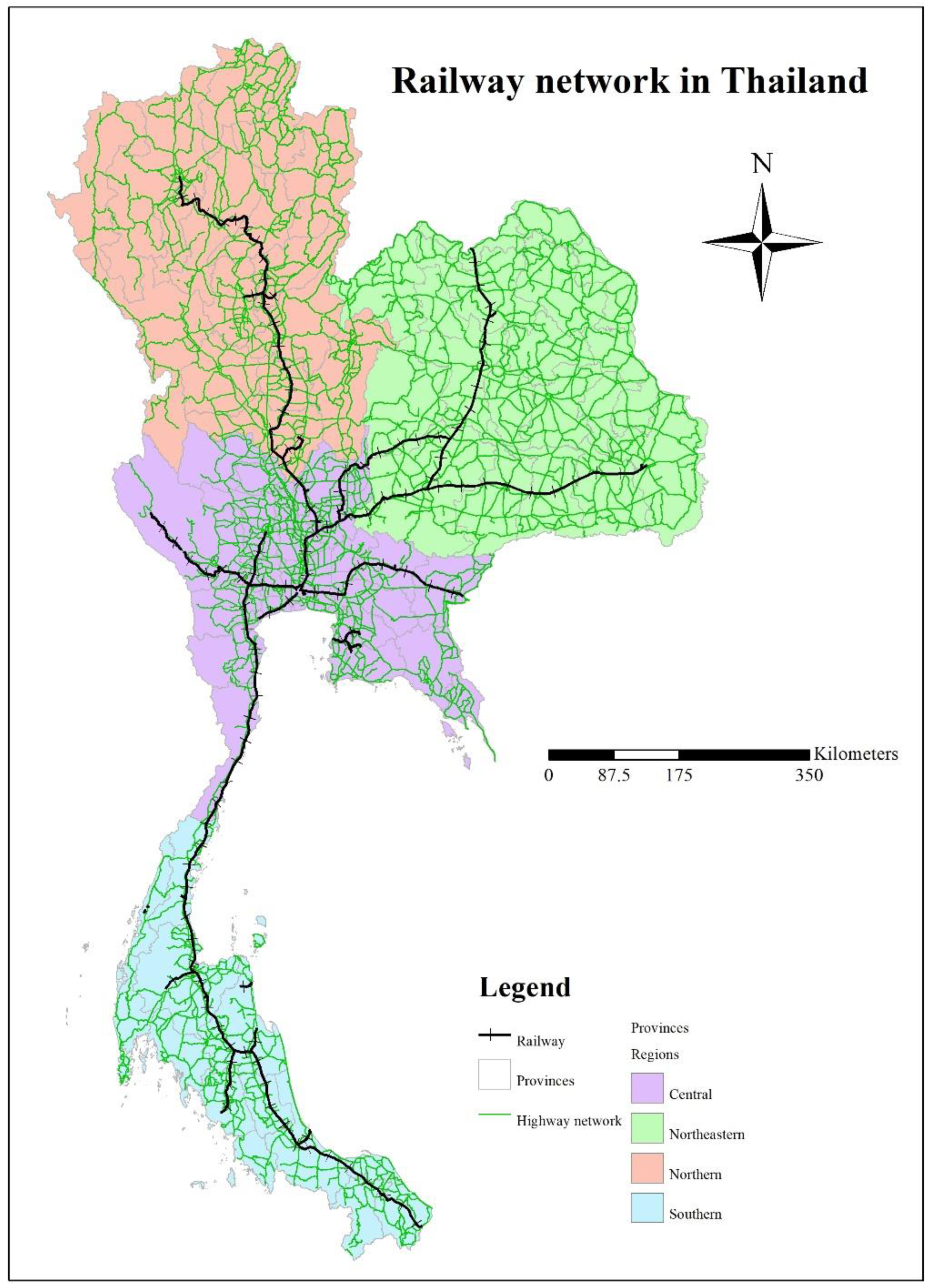
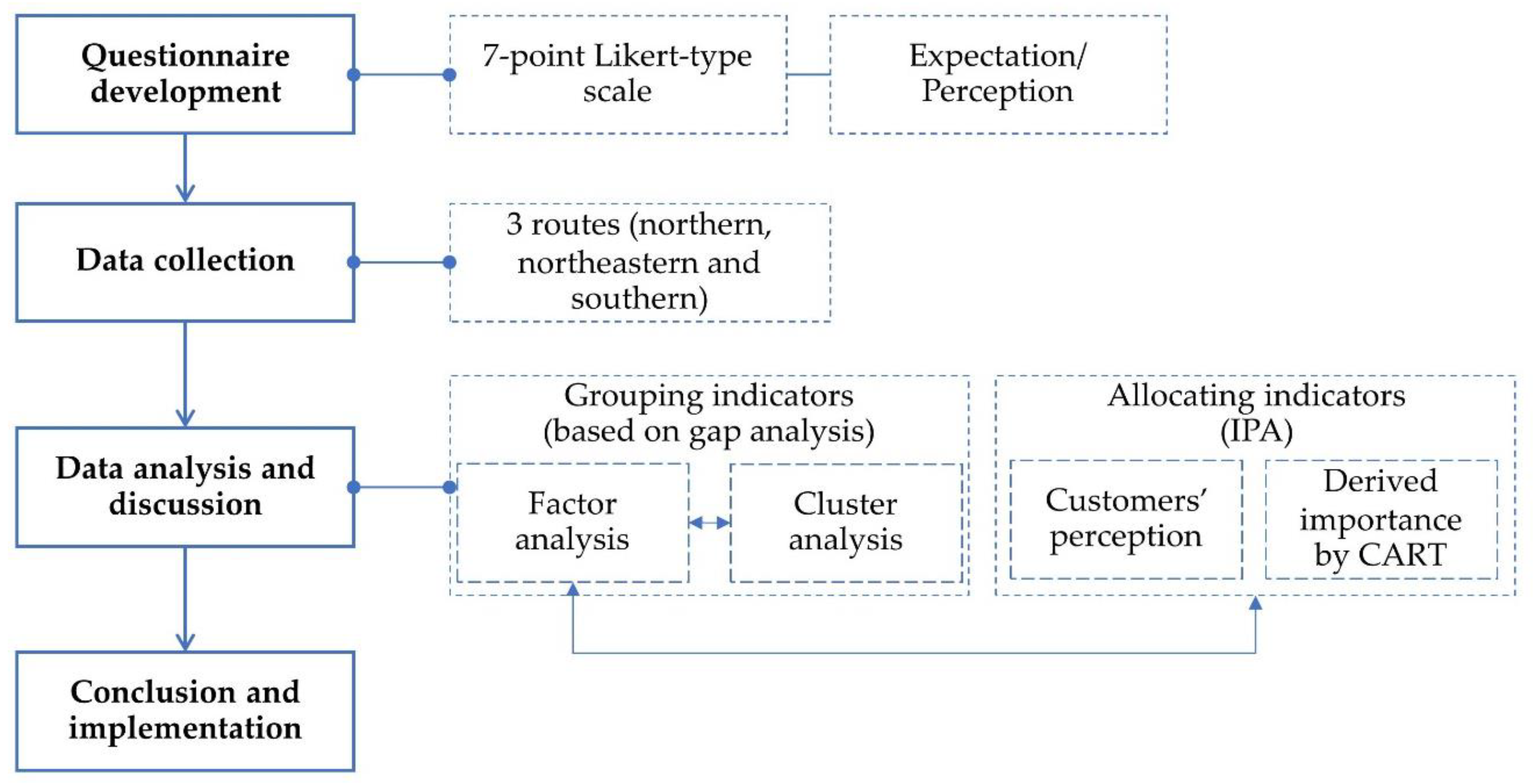
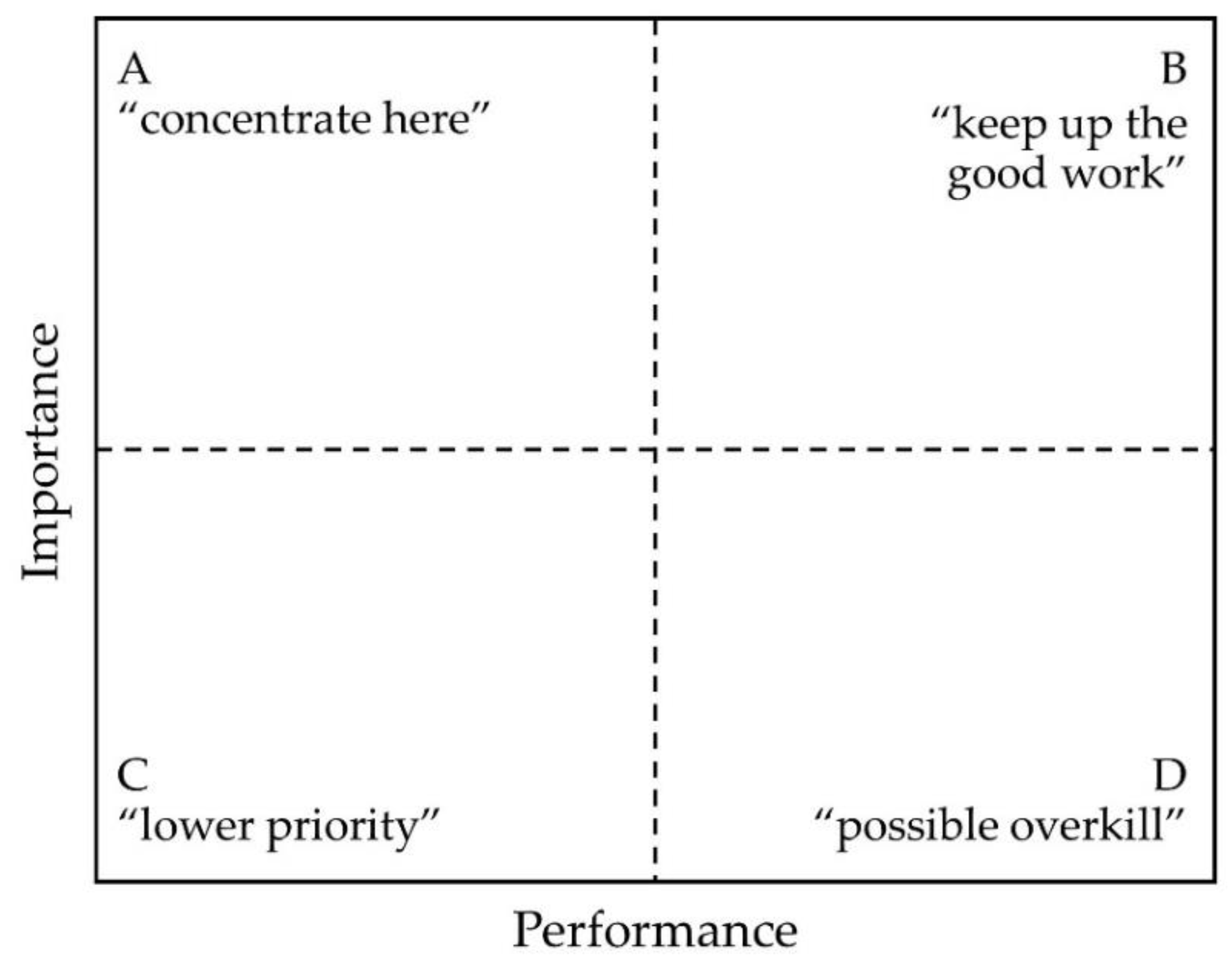
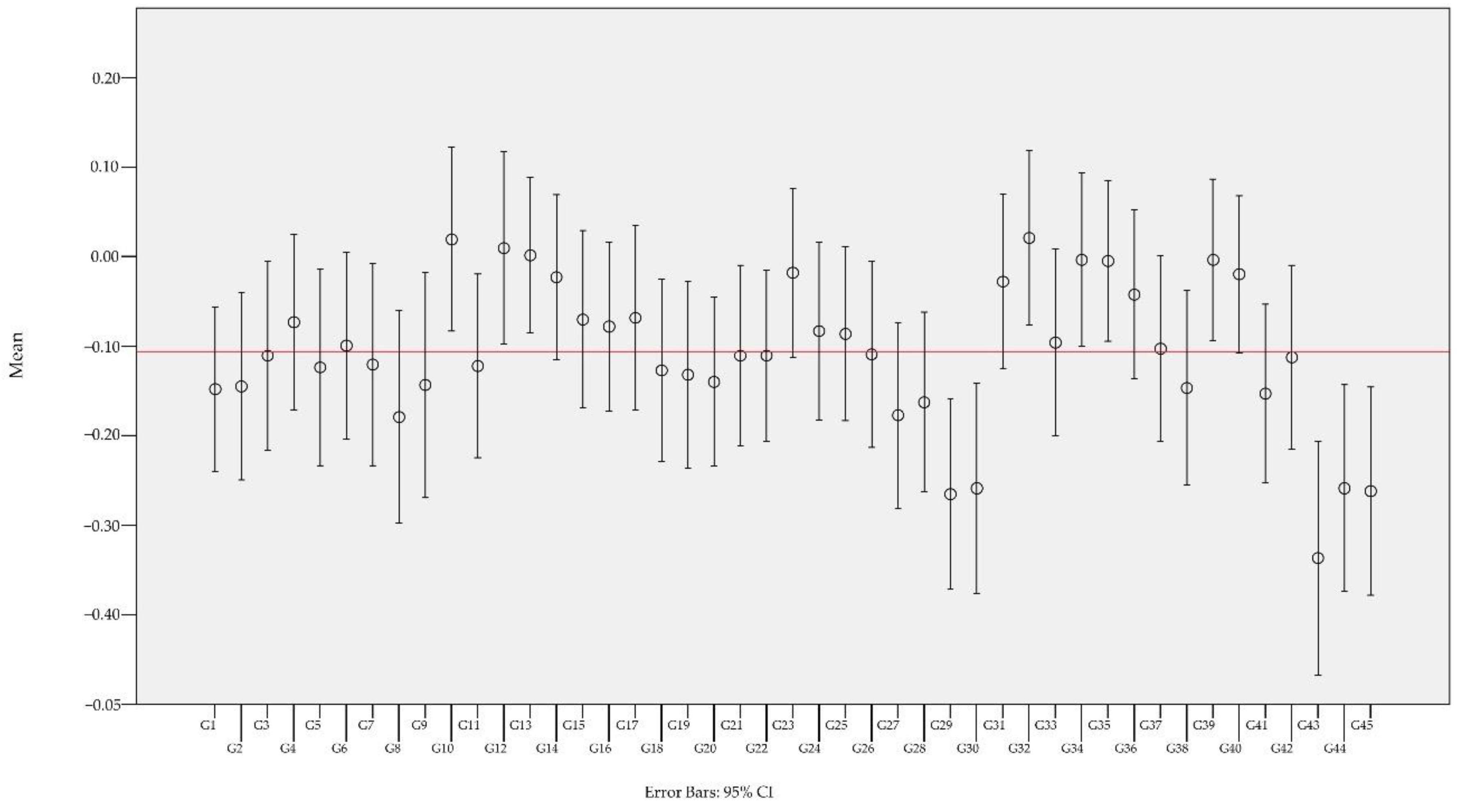
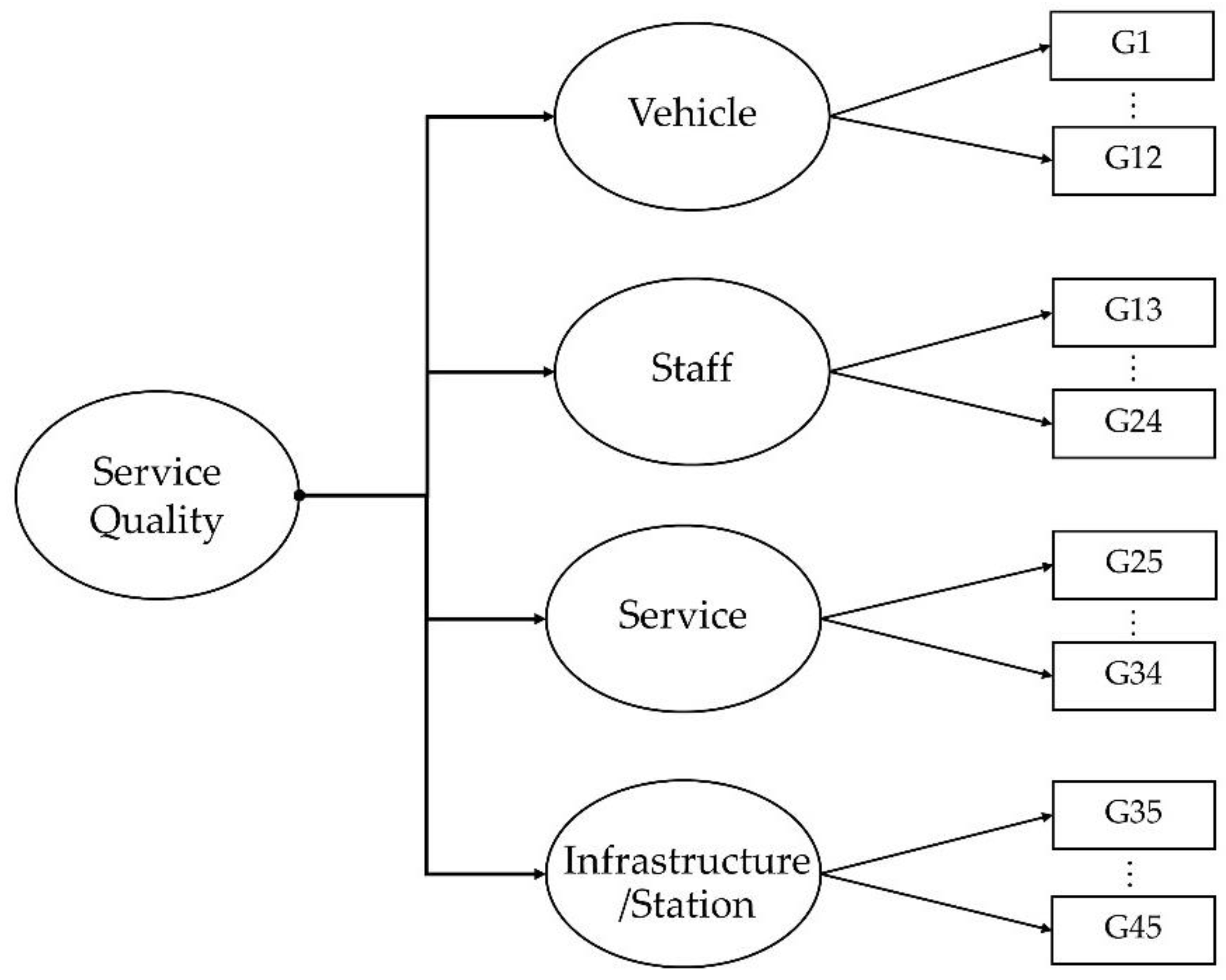
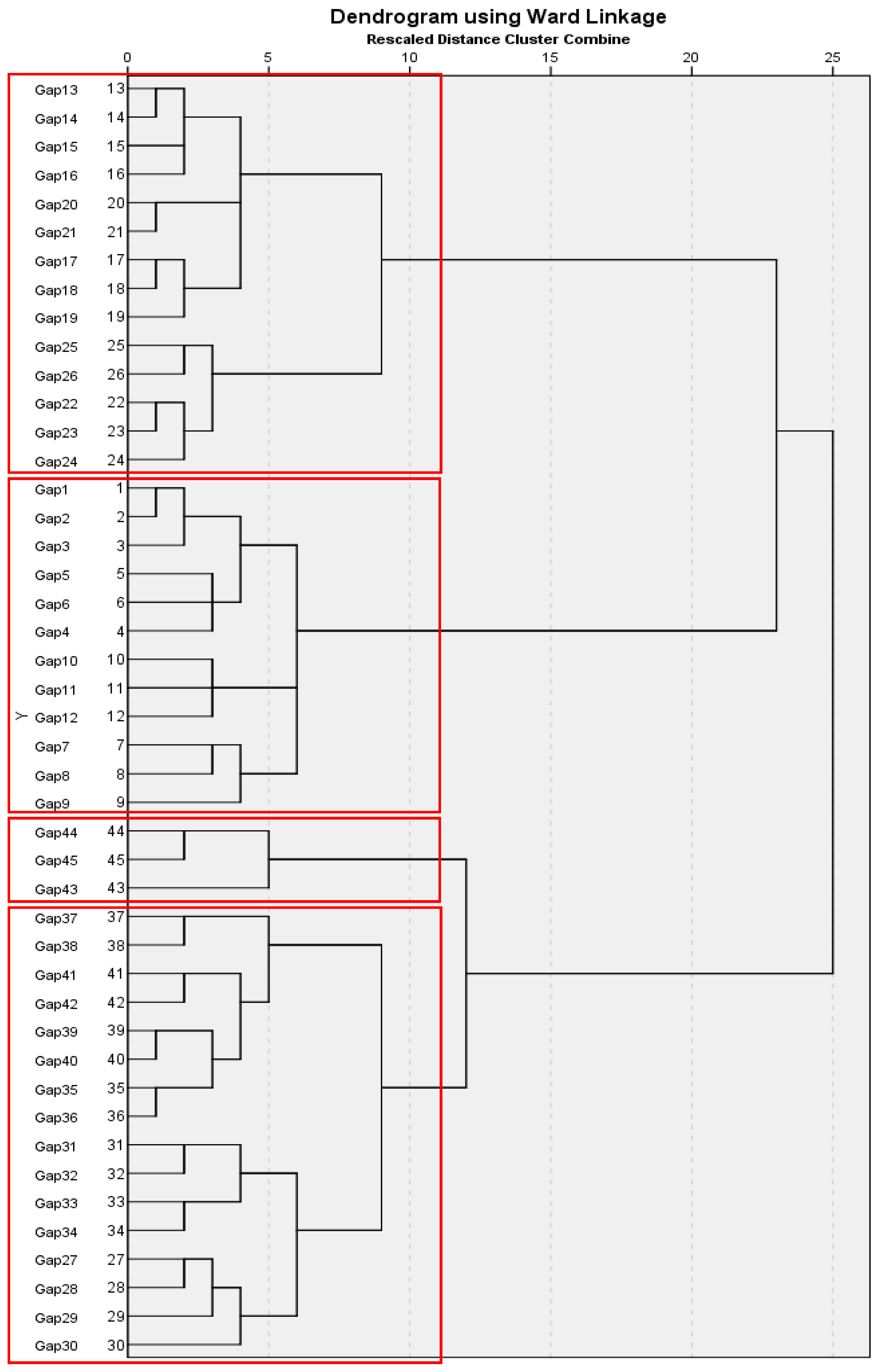
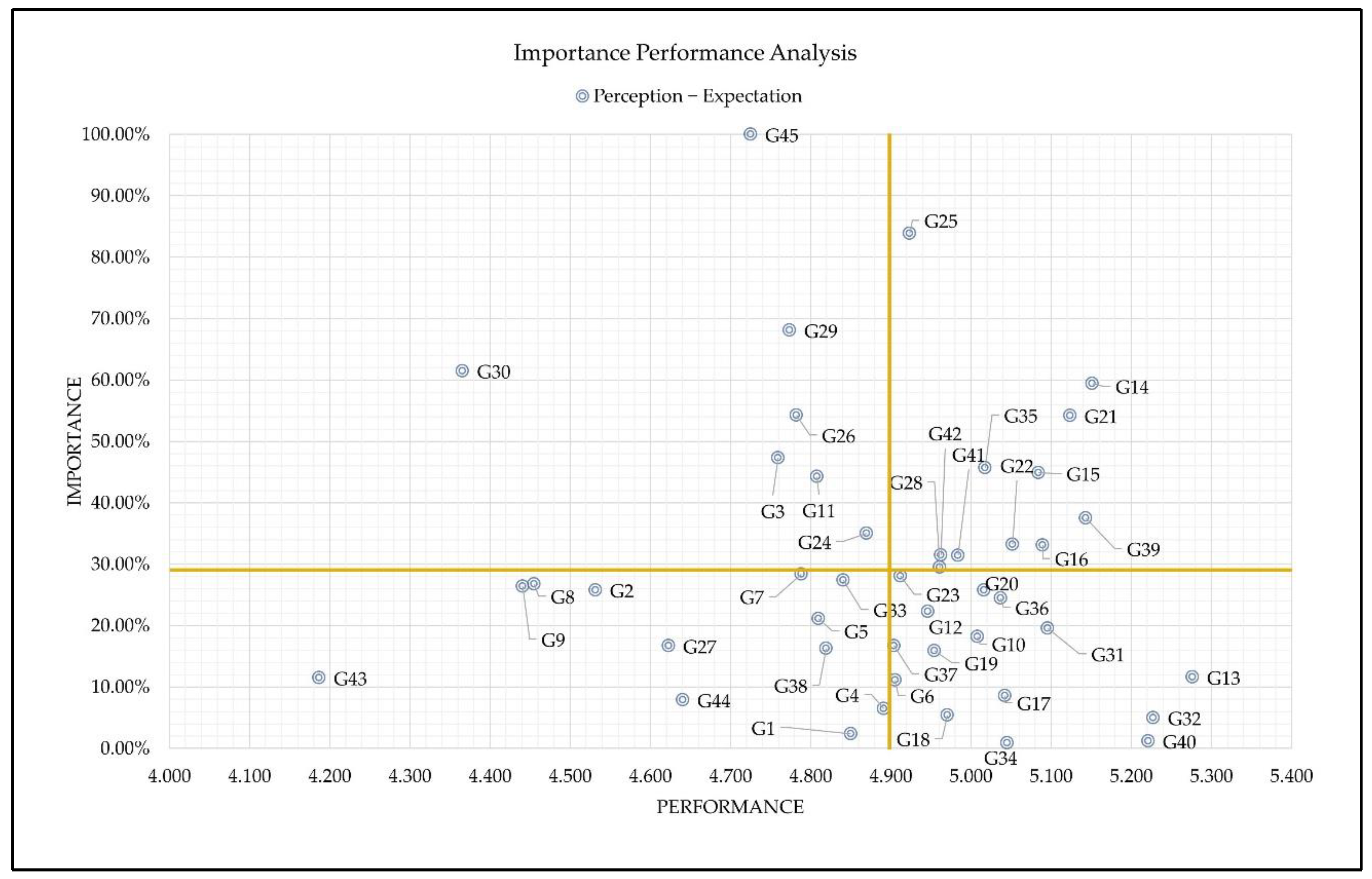
| Characteristics | Train Types in Thailand | Total | % | ||||||
|---|---|---|---|---|---|---|---|---|---|
| SP EXP | EXP | RAP | |||||||
| Freq. | % | Freq. | % | Freq. | % | ||||
| Region | Northern line | 40 | 6.50% | 35 | 5.69% | 135 | 21.95% | 210 | 34.15% |
| Northeastern line | 134 | 21.79% | 49 | 7.97% | 17 | 2.76% | 200 | 32.52% | |
| Southern line | 69 | 11.22% | 49 | 7.97% | 87 | 14.15% | 205 | 33.33% | |
| Gender | Male | 75 | 12.20% | 52 | 8.46% | 89 | 14.47% | 216 | 35.12% |
| Female | 168 | 27.32% | 81 | 13.17% | 150 | 24.39% | 399 | 64.88% | |
| Education | Elementary school | 5 | 0.81% | 2 | 0.33% | 21 | 3.41% | 28 | 4.55% |
| Primary | 5 | 0.81% | 6 | 0.98% | 27 | 4.39% | 38 | 6.18% | |
| High school | 66 | 10.73% | 30 | 4.88% | 68 | 11.06% | 164 | 26.67% | |
| High vocational | 81 | 13.17% | 56 | 9.11% | 66 | 10.73% | 203 | 33.01% | |
| Bachelor | 78 | 12.68% | 36 | 5.85% | 56 | 9.11% | 170 | 27.64% | |
| Master | 7 | 1.14% | 3 | 0.49% | 1 | 0.16% | 11 | 1.79% | |
| Doctoral | 1 | 0.16% | 0 | 0.00% | 0 | 0.00% | 1 | 0.16% | |
| Salary (THB/Month) | <10,000 | 127 | 20.65% | 44 | 7.15% | 118 | 19.19% | 289 | 46.99% |
| 10,000–14,999 | 39 | 6.34% | 28 | 4.55% | 53 | 8.62% | 120 | 19.51% | |
| 15,000–19,999 | 22 | 3.58% | 31 | 5.04% | 37 | 6.02% | 90 | 14.63% | |
| 20,000–24,999 | 17 | 2.76% | 11 | 1.79% | 18 | 2.93% | 46 | 7.48% | |
| 25,000–29,999 | 25 | 4.07% | 12 | 1.95% | 10 | 1.63% | 47 | 7.64% | |
| >30,000 | 13 | 2.11% | 7 | 1.14% | 3 | 0.49% | 23 | 3.74% | |
| Occupation | Government/state enterprises | 54 | 8.78% | 36 | 5.85% | 22 | 3.58% | 112 | 18.21% |
| Company employees | 29 | 4.72% | 31 | 5.04% | 46 | 7.48% | 106 | 17.24% | |
| Personal business | 18 | 2.93% | 12 | 1.95% | 29 | 4.72% | 59 | 9.59% | |
| Farmers | 4 | 0.65% | 3 | 0.49% | 4 | 0.65% | 11 | 1.79% | |
| Students | 117 | 19.02% | 30 | 4.88% | 75 | 12.20% | 222 | 36.10% | |
| Other | 21 | 3.41% | 21 | 3.41% | 63 | 10.24% | 105 | 17.07% | |
| Purpose | Hometown | 99 | 16.10% | 36 | 5.85% | 94 | 15.28% | 229 | 37.24% |
| Traveling | 64 | 10.41% | 43 | 6.99% | 67 | 10.89% | 174 | 28.29% | |
| Working | 29 | 4.72% | 15 | 2.44% | 14 | 2.28% | 58 | 9.43% | |
| Visiting relations | 43 | 6.99% | 35 | 5.69% | 44 | 7.15% | 122 | 19.84% | |
| Other | 8 | 1.30% | 4 | 0.65% | 20 | 3.25% | 32 | 5.20% | |
| Frequency | once a week | 40 | 6.50% | 14 | 2.28% | 51 | 8.29% | 105 | 17.07% |
| once every two-weeks | 20 | 3.25% | 8 | 1.30% | 28 | 4.55% | 56 | 9.11% | |
| once a month | 23 | 3.74% | 9 | 1.46% | 29 | 4.72% | 61 | 9.92% | |
| once every two months | 49 | 7.97% | 22 | 3.58% | 48 | 7.80% | 119 | 19.35% | |
| once every 4–6 months | 31 | 5.04% | 25 | 4.07% | 34 | 5.53% | 90 | 14.63% | |
| once a year | 80 | 13.01% | 55 | 8.94% | 49 | 7.97% | 184 | 29.92% | |
| Total | 243 | 39.51% | 133 | 21.63% | 239 | 38.86% | 615 | 100.00% | |
| Variable | Description | EFA | CFA | |||||||
|---|---|---|---|---|---|---|---|---|---|---|
| Communalities | Loading | Explained Variance (%) | Cronbach’s α | Loading | t-Value | Error Variance | CR | AVE | ||
| Factor 1 | 15.900 | 0.973 | 0.997 | 0.743 | ||||||
| G1 | Decent vehicle body appearance. | 0.611 | 0.703 | 0.715 | 33.843 | 0.021 | ||||
| G2 | No engine noise disturbance when inside the train. | 0.657 | 0.704 | 0.773 | 43.899 | 0.018 | ||||
| G3 | Neat and clean train interior. | 0.652 | 0.715 | 0.767 | 42.609 | 0.018 | ||||
| G4 | Cool but convenient interior temperature. | 0.529 | 0.654 | 0.673 | 28.838 | 0.023 | ||||
| G5 | Clean train seats. | 0.634 | 0.704 | 0.756 | 40.638 | 0.019 | ||||
| G6 | Train seats with an appropriate space between two seats in a row. | 0.579 | 0.654 | 0.735 | 36.961 | 0.020 | ||||
| G7 | Train seats are adjustable, of a suitable size, and convenient to use. | 0.611 | 0.670 | 0.755 | 40.366 | 0.019 | ||||
| G8 | Variety of entertainment devices available in good working condition. | 0.651 | 0.631 | 0.802 | 50.731 | 0.016 | ||||
| G9 | Clean, convenient toilets and washrooms. | 0.626 | 0.610 | 0.788 | 47.286 | 0.017 | ||||
| G10 | Enough train carriages of appropriate size. | 0.531 | 0.577 | 0.715 | 34.013 | 0.021 | ||||
| G11 | Properly functioning windows and doors. | 0.576 | 0.609 | 0.739 | 37.577 | 0.020 | ||||
| G12 | Onboard food and drink services. | 0.543 | 0.528 | 0.702 | 32.197 | 0.022 | ||||
| Factor 2 | 16.214 | 0.935 | 0.997 | 0.733 | ||||||
| G13 | Neat and clear train crews. | 0.515 | 0.631 | 0.648 | 25.985 | 0.025 | ||||
| G14 | On-time, accurate delivery of advertised services. | 0.634 | 0.703 | 0.732 | 36.002 | 0.020 | ||||
| G15 | Crew able and willing to solve onboard problems. | 0.685 | 0.734 | 0.788 | 46.721 | 0.017 | ||||
| G16 | Crews deliver information before the start of every service. | 0.618 | 0.730 | 0.732 | 36.065 | 0.020 | ||||
| G17 | Crews can deliver fast and accurate services. | 0.671 | 0.730 | 0.784 | 45.572 | 0.017 | ||||
| G18 | Crews are always willing to help. | 0.598 | 0.664 | 0.747 | 38.296 | 0.020 | ||||
| G19 | Crews respond willingly to all passenger requests. | 0.636 | 0.692 | 0.779 | 44.718 | 0.017 | ||||
| G20 | Crew behavior makes passengers confident about the service. | 0.579 | 0.648 | 0.752 | 39.458 | 0.019 | ||||
| G21 | Crews deliver services politely. | 0.613 | 0.663 | 0.776 | 43.942 | 0.018 | ||||
| G22 | Crews are knowledgeable and can provide accurate, complete information. | 0.608 | 0.528 | 0.723 | 34.699 | 0.021 | ||||
| G23 | Attentive personal passenger service. | 0.533 | 0.504 | 0.653 | 26.603 | 0.025 | ||||
| G24 | Passenger service willingness by crews. | 0.589 | 0.525 | 0.683 | 29.577 | 0.023 | ||||
| Factor 3 | 12.397 | 0.914 | 0.996 | 0.717 | ||||||
| G25 | Passenger service is important to the State Railway of Thailand. | 0.580 | 0.514 | 0.673 | 28.375 | 0.024 | ||||
| G26 | Crews understand special passenger requirements. | 0.566 | 0.522 | 0.674 | 28.545 | 0.024 | ||||
| G27 | Train timetables and train frequencies are suitable. | 0.665 | 0.691 | 0.742 | 37.466 | 0.020 | ||||
| G28 | Safe traveling conditions (without accidents or broken-down trains). | 0.621 | 0.625 | 0.763 | 41.228 | 0.019 | ||||
| G29 | Security system available to prevent crime. | 0.624 | 0.641 | 0.746 | 38.336 | 0.019 | ||||
| G30 | Punctuality. | 0.558 | 0.480 | 0.731 | 35.858 | 0.020 | ||||
| G31 | Enough ticket counters. | 0.514 | 0.469 | 0.722 | 34.566 | 0.021 | ||||
| G32 | Suitable ticket prices. | 0.501 | 0.518 | 0.696 | 31.086 | 0.022 | ||||
| G33 | Suitable onboard meal prices. | 0.555 | 0.569 | 0.706 | 32.399 | 0.022 | ||||
| G34 | Services received as agreed on the ticket. | 0.551 | 0.573 | 0.713 | 33.314 | 0.021 | ||||
| Factor 4 | 14.854 | 0.926 | 0.996 | 0.727 | ||||||
| G35 | Terminal provides enough trip guidance and information. | 0.563 | 0.549 | 0.715 | 33.204 | 0.022 | ||||
| G36 | Provides information when train timetable changes. | 0.559 | 0.575 | 0.718 | 33.851 | 0.021 | ||||
| G37 | Provides connecting information to other public transportation. | 0.603 | 0.574 | 0.744 | 37.645 | 0.020 | ||||
| G38 | Provides a complaint channel. | 0.588 | 0.589 | 0.744 | 37.611 | 0.020 | ||||
| G39 | Suitable terminal sizes. | 0.567 | 0.673 | 0.678 | 28.797 | 0.024 | ||||
| G40 | Suitable terminal locations, ease of dis/embarking. | 0.535 | 0.641 | 0.665 | 27.493 | 0.024 | ||||
| G41 | Cleanliness of terminals. | 0.648 | 0.720 | 0.752 | 38.969 | 0.019 | ||||
| G42 | Enough seats inside the terminals. | 0.593 | 0.659 | 0.743 | 37.436 | 0.020 | ||||
| G43 | Other convenient infrastructure, e.g., Wi-Fi. | 0.612 | 0.653 | 0.750 | 38.553 | 0.019 | ||||
| G44 | Enough car parks at the terminals. | 0.609 | 0.658 | 0.741 | 36.899 | 0.020 | ||||
| G45 | Security system available to prevent crime at terminals. | 0.620 | 0.668 | 0.747 | 38.083 | 0.020 | ||||
© 2020 by the authors. Licensee MDPI, Basel, Switzerland. This article is an open access article distributed under the terms and conditions of the Creative Commons Attribution (CC BY) license (http://creativecommons.org/licenses/by/4.0/).
Share and Cite
Jomnonkwao, S.; Champahom, T.; Ratanavaraha, V. Methodologies for Determining the Service Quality of the Intercity Rail Service Based on Users’ Perceptions and Expectations in Thailand. Sustainability 2020, 12, 4259. https://doi.org/10.3390/su12104259
Jomnonkwao S, Champahom T, Ratanavaraha V. Methodologies for Determining the Service Quality of the Intercity Rail Service Based on Users’ Perceptions and Expectations in Thailand. Sustainability. 2020; 12(10):4259. https://doi.org/10.3390/su12104259
Chicago/Turabian StyleJomnonkwao, Sajjakaj, Thanapong Champahom, and Vatanavongs Ratanavaraha. 2020. "Methodologies for Determining the Service Quality of the Intercity Rail Service Based on Users’ Perceptions and Expectations in Thailand" Sustainability 12, no. 10: 4259. https://doi.org/10.3390/su12104259
APA StyleJomnonkwao, S., Champahom, T., & Ratanavaraha, V. (2020). Methodologies for Determining the Service Quality of the Intercity Rail Service Based on Users’ Perceptions and Expectations in Thailand. Sustainability, 12(10), 4259. https://doi.org/10.3390/su12104259







